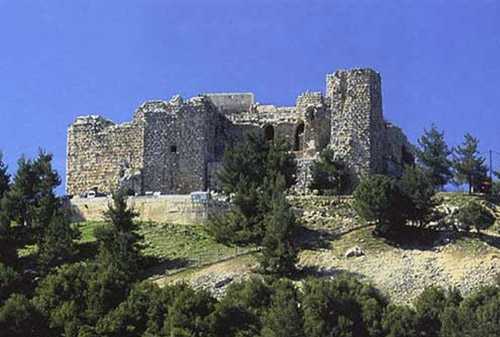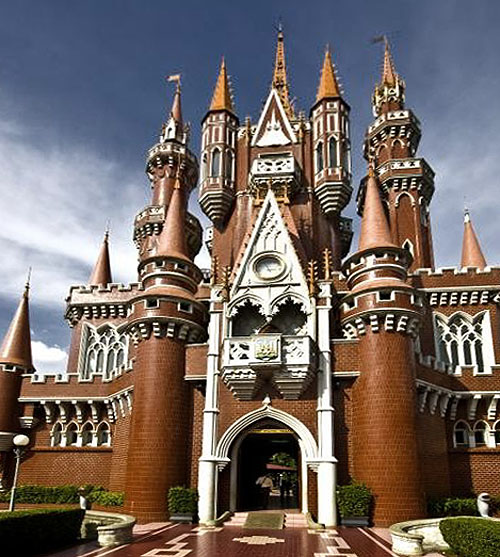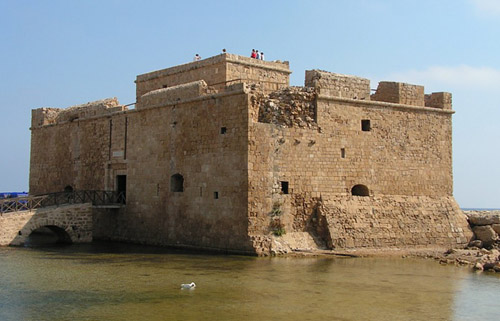Photographs of
|
|
|
|||||||||
|
|
|||||||||
 |
Ajloun Castle built atop Jabal Auf near Ajloun northern Jordan |
||||||||
 |
Citadel of Aleppo, Aleppo, Syria
The Citadel of Aleppo is a large medieval fortified palace in the centre of the old city. It one of the oldest and largest castles in the world. Usage of the Citadel hill dates back at least to the middle of the 3rd millennium BC. Subsequently occupied by many civilizations including the Greeks, Byzantines, Ayyubids and Mamluks, the majority of the construction as it stands today is thought to originate from the Ayyubid period. Extensive conservation work has taken place in the 2000s by the Aga Khan Trust for Culture in collaboration with Aleppo Archeological Society.
Dominating the city, the Citadel is part of the Ancient City of Aleppo, a UNESCO World Heritage Site since 1986. The Citadel received significant damage in the Syrian Civil War from 2013. |
||||||||
 |
Amarah Palace, Najran, Aba Al Saud Historical Area, Saudi Arabia
Amarah or Emara Palace is a daub castle located in the central ancient city in Najran. It is a good example of the traditional architecture of the region.
The castle was built from daub (mud & straw) with its foundations built of stones. It is composed of 65 rooms and housed the local governor and his deputy and personal companions (khawis). The building takes the shape of a classic castle with high rectangular walls and round guard towers at the four corners. Inside (shown in the photo) is a well which dates back to pre-Islamic age. |
||||||||
 |
Istana Anak-anak, (Castle of Indonesian Children), Indonesia
Indonesian stamp
|
||||||||
 |
Arg-é Bam (Bam Citadel), Bam, Kerman Province, southeastern Iran
The Arg-e Bam was the largest adobe building in the world. It was a lrge fortress/city in whose heart the citadel was located, but because of the impressive look of the citadel, which forms the highest point, the entire fortress is referred to as the Bam Citadel.
It is listed by UNESCO as part of the World Heritage Site
The origin of this massive citadel on the Silk Road can be traced beyondthe Achaemenid period (6th to 4th centuries BC). The heyday of the citadel was from the 7th to 11th centuries, when it lay at the crossroads of important trade routes and known for the production of silk and cotton garments.
On December 26, 2003, the Citadel was almost completely destroyed by an earthquake, along with much of the rest of Bam. It is currently being rebuilt. |
||||||||
 |
Arg-e-Bam (Bam Citadel) Bam Kerman Province Iran |
||||||||
 |
City Walls, Arg-é Bam (Bam Citadel), Bam, Kerman Province, southeastern Iran
The Arg-e Bam was the largest adobe building in the world. It was a lrge fortress/city in whose heart the citadel was located, but because of the impressive look of the citadel, which forms the highest point, the entire fortress is referred to as the Bam Citadel.
It is listed by UNESCO as part of the World Heritage Site
The origin of this massive citadel on the Silk Road can be traced beyondthe Achaemenid period (6th to 4th centuries BC). The heyday of the citadel was from the 7th to 11th centuries, when it lay at the crossroads of important trade routes and known for the production of silk and cotton garments.
On December 26, 2003, the Citadel was almost completely destroyed by an earthquake, along with much of the rest of Bam. It is currently being rebuilt. |
||||||||
 |
Interior, Arg-é Bam (Bam Citadel), Bam, Kerman Province, southeastern Iran
The Arg-e Bam was the largest adobe building in the world. It was a lrge fortress/city in whose heart the citadel was located, but because of the impressive look of the citadel, which forms the highest point, the entire fortress is referred to as the Bam Citadel.
It is listed by UNESCO as part of the World Heritage Site
The origin of this massive citadel on the Silk Road can be traced beyondthe Achaemenid period (6th to 4th centuries BC). The heyday of the citadel was from the 7th to 11th centuries, when it lay at the crossroads of important trade routes and known for the production of silk and cotton garments.
On December 26, 2003, the Citadel was almost completely destroyed by an earthquake, along with much of the rest of Bam. It is currently being rebuilt. |
||||||||
 |
Arg-é Bam (Bam Citadel), Bam, Kerman Province, southeastern Iran
The Arg-e Bam was the largest adobe building in the world. It was a lrge fortress/city in whose heart the citadel was located, but because of the impressive look of the citadel, which forms the highest point, the entire fortress is referred to as the Bam Citadel.
It is listed by UNESCO as part of the World Heritage Site
The origin of this massive citadel on the Silk Road can be traced beyondthe Achaemenid period (6th to 4th centuries BC). The heyday of the citadel was from the 7th to 11th centuries, when it lay at the crossroads of important trade routes and known for the production of silk and cotton garments.
On December 26, 2003, the Citadel was almost completely destroyed by an earthquake, along with much of the rest of Bam. It is currently being rebuilt. |
||||||||
 |
Bahla Fort situated at the foot of the Djebel Akhdar highlands Oman |
||||||||
 |
Beijing Beihai Park, Wenjin St, Xicheng, Beijing, China
Beihai Park was an imperial garden and is now a public park located to the Northwest of the Forbidden City. |
||||||||
 |
Boyabat castle Boyabat Boyabat district Sinop Province Black Sea region Turkey |
||||||||
 |
Bozcaada Castle formerly known as Tenedos Bozcaada Bozcaada district Çanakkale province Turkey
Bozcaada Castle is one of the best preserved castles of Turkey |
||||||||
 |
Byblos Castle Byblos Lebanon |
||||||||
 |
Chor Minor, Khodja Nurobobod St, Bukhara, Uzbekistan |
||||||||
 |
Derawar Fort, Cholistan Desert, Pakistan
Derawar Fort is a large square fortress near Bahawalpur.
The forty bastions of Derawar are visible for many miles around in Cholistan Desert. The walls have a circumference of 1500 metres and stand up to thirty metres high.
The first fort on the site was built by Hindu Rajput, Rai Jajja Bhati of Jaisalmer. It remained in the hands of the royal family of Jaisalmer until captured by the Nawabs of Bahawalpur in 1733. In 1747, the fort was lost but, Nawab Mubarak Khan took the stronghold back in 1804. |
||||||||
 |
Interior view of the dome Emam (Shah abbasi) Mosque Isfahan, Iran.
The mosque was built during the Safavid period, ordered by the first Shah Abbas of Persia. It is regarded as an excellent example of Islamic era architecture of Iran. It is registered, along with the Naghsh-e Jahan Square, as a UNESCO World Heritage Site.
Its construction began in 1611, and its splendor is mainly due to the beauty of its seven-colour mosaic tiles and calligraphic inscriptions. |
||||||||
 |
Falak-ol-Aflak Castle within the city of Khorramabad Lorestan Province Iran. |
||||||||
 |
Dar Al Hajar Wadi Dhahr Valley, Yemen.
Dar al-Hajar, also known as the Imam's Rock Palace is perched on top of a rock pinnacle, some 15 km away from the capita city of Sana.
It is typical of Yemeni architecture, seeming to grow out of the rocks on which it is constructed, and with characteristic Yemeni painting of its windows and building edges.
The palace was built in the 1930s by Imam Yahya as his summer residence (Most of the apparently ancient castles in this part of the world are less than a century old)
The palace has been restored for visitors, and turned into a museum. |
||||||||
 |
Khiva City Walls Xorazm Province Uzbekistan. |
||||||||
 |
Khiva City Walls Xorazm Province Uzbekistan. |
||||||||
 |
Kolossi Castle west of Limassol Cyprus |
||||||||
 |
Krak des Chevaliers (or Crac Des Chevaliers) Syria
Krak Des Chevaliers is one of the most important preserved medieval castles in the world. The site was settled in the 11th century by Kurds; as a result it was known as Hisn al Akrad, meaning the "Castle of the Kurds". In 1142 it was given by Raymond II, Count of Tripoli, to the Knights Hospitaller. It remained in their possession until it fell in 1271. It was known as Crac de l'Ospital (the name Krak Des Chevaliers was coined only in the 19th century.) |
||||||||
 |
Krak des Chevaliers (or Crac Des Chevaliers) Syria
Krak des Chevaliers is one of the most important preserved medieval castles in the world. The site was settled in the 11th century by Kurds; as a result it was known as Hisn al Akrad, meaning the "Castle of the Kurds". In 1142 it was given by Raymond II, Count of Tripoli, to the Knights Hospitaller. It remained in their possession until it fell in 1271. It was known as Crac de l'Ospital (the name Krak des Chevaliers was coined only in the 19th century.) |
||||||||
 |
Krak Des Chevaliers (or Crac Des Chevaliers) Syria
Krak Des Chevaliers is one of the most important preserved medieval castles in the world. The site was settled in the 11th century by Kurds; as a result it was known as Hisn al Akrad, meaning the "Castle of the Kurds". In 1142 it was given by Raymond II, Count of Tripoli, to the Knights Hospitaller. It remained in their possession until it fell in 1271. It was known as Crac de l'Ospital (the name Krak Des Chevaliers was coined only in the 19th century.) |
||||||||
 |
Krak des Chevaliers (or Crac Des Chevaliers) Syria
Krak des Chevaliers is one of the most important preserved medieval castles in the world. The site was settled in the 11th century by Kurds; as a result it was known as Hisn al Akrad, meaning the "Castle of the Kurds". In 1142 it was given by Raymond II, Count of Tripoli, to the Knights Hospitaller. It remained in their possession until it fell in 1271. It was known as Crac de l'Ospital (the name Krak des Chevaliers was coined only in the 19th century.) |
||||||||
 |
Kyrenia Castle Kyrenia (a 16th-century castle built by Venetians on an earlier CRUSADER CASTLE) Cyprus |
||||||||
 |
Mamure kalesi (Mamure Castle) Anamur District Mersin Province Turkey |
||||||||

|
Mardan Palace Antalya Turkey |
||||||||
 |
Paphos Castle Paphos harbour. (Built as a Byzantine fort, rebuilt as a CRUSADER CASTLE) Cyprus |
||||||||
 |
Qaitbay Citadel, Alexandria, Egypt
The Citadel of Qaitbay (or the Fort of Qaitbay) is a 15th-century defensive fortress located on the Mediterranean sea coast at Alexandria, on the eastern side of the northern tip of Pharos Island at the mouth of the Eastern Harbour.
It is built on the site of the famous Lighthouse of Alexandria - probably from stones from the ruined lighthouse.
It was built in 1477 AD by Sultan Al-Ashraf Sayf al-Din Qa'it Bay, from whom it takes its name. |
||||||||
 |
Qaitbay Citadel, Alexandria, Egypt
The Citadel of Qaitbay (or the Fort of Qaitbay) is a 15th-century defensive fortress located on the Mediterranean sea coast at Alexandria, on the eastern side of the northern tip of Pharos Island at the mouth of the Eastern Harbour.
It is built on the site of the famous Lighthouse of Alexandria - probably from stones from the ruined lighthouse.
It was built in 1477 AD by Sultan Al-Ashraf Sayf al-Din Qa'it Bay, from whom it takes its name. |
||||||||
 |
Qalat_al-Bahr (Sidon Sea Castle) Sidon Old Citadel Lebanon |
||||||||
 |
Qalat_al-Bahr (Sidon Sea Castle) Sidon Lebanon. |
||||||||
|
|||||||||
 |
Qasr al-Hayr al-Sharqi in the Syrian Desert. |
||||||||
 |
Ribat of Monastir, Tunisia.
Ribat of Monastir on the Mediterranean coast is the oldest and largest Maghreb Ribat. Built in 796 by the Abbasid general and governor of Ifriqiya, Harthimâ Ibn A’yûn, the complex that can be seen today is the result of a long evolution of successive additions and changes. The original nucleus of the building presents a regular plan with massive façades with cylindrical towers at the corners and a watchtower located to the southeast. The courtyard is lined with galleries which open on several stories. |
||||||||
 |
Ribat Castle Sousse Sousse Tunisia |
||||||||
 |
Rohtas Fort, Punjab, Pakistan
Rohtas Fort is a historical garrison fort located near the city of Jhelum in Punjab.
It was built by the Afghan king Sher Shah Suri in 16th century to subdue the rebellious tribes of the northern Punjab region, .
This fort is about 4 km in circumference and is UNESCO World Heritage Site |
||||||||
 |
Rudkhan Castle (or Rood-khan Castle) southwest of Foman city, Gilan province, Iran
Rudkhan Castle is a brick and stone medieval military complex constructed during the Seljuk Dynasty by followers of the Isma'ili sect.
The castle's 42 towers still stand intact. |
||||||||
 |
Citadel of Salah Ed-Din Syria. Saône or Saladin Castle, Al-Haffah, Latakia Governorate, Syria
the site has been fortified since at least the mid 10th century. In 975 the Byzantine Emperor John I Tzimiskes captured the site and it remained under Byzantine control until around 1108.
Early in the 12th century crusaders assumed control of the site and it became part of the newly formed Principality of Antioch. The Crusaders undertook an extensive building programme, giving the castle much of its current appearance.
In 1188 it fell to the forces of Saladin after a three-day siege.
In 2006, the castles of Qal'at Salah El-Din and Krak Des Chevaliers were together recognised as a World Heritage Site by UNESCO. |
||||||||
 |
Saladin Citadel, Cairo, Egypt.
The Saladin Citadel is a medieval Islamic fortification, on Mokattam hill near the center of Cairo. |
||||||||
 |
Minaret of Great Mosque, Samarra, Iraq
The Great Mosque of Samarra was a 9th-century mosque commissioned in 848 and completed in 851 by the Abbasid caliph Al-Mutawakkil.
The Great Mosque of Samarra was at one time the largest mosque in the world; its minaret, the Malwiya Tower, is a vast spiralling cone 52 meters high and 33 meters wide with a spiral ramp.
The mosque was destroyed in 1278 CE after the Hulagu Khan invasion of Iraq. Today, only the outer wall and its minaret remain. |
||||||||
 |
Citadel of Raymond de Saint-Gilles (Qala'at Sanjil) Tripoli, Lebanon.
The citadel takes its name from Raymond IV, Raymond de Saint-Gilles, the Count of Toulouse and Crusader commander. He started its construction on a hilltop outside Tripoli in 1103 in order to lay siege to the city during the First Crusade. Later, Raymond enlarged the fortress, which he named Mont Peregrinus ("Mount Pilgrim").
Iit is not be confused with the Citadel of Tripoli, built by the Arabs in 636 and subsequently enlarged and modified by the Fatamids of Egypt and, later, by the Crusaders and Ottomans). |
||||||||

|
Sazova Mahallesi Eskisehir Turkey |
||||||||
 |
Château de Suse (Shush Castle) Susa (Shush) Khuzestan Province Iran
[constructed by French archaeologist |
||||||||
 |
The University of Timbuktu, located in the city of Timbuktu, Mali, West Africa
The University of Timbuktu was established in the 12th century. Teaching included geography, mathematics, the sciences, and medicine.
During the 12th century, the university had an enrollment of around 25,000 students from Africa as well as parts of the Mediterranean within a city of around 100,000 persons.
The castle like construction is useful when, periodically, religious fanatics attempt to destroy University facilities, artefacts and manuscrits, most recently in 2013. |
||||||||
 |
Tizourgane Chtouka Aït Baha Souss-Massa-Drâa Morocco
Tizourgane is in the Antiatlas mountains |
||||||||
|
|
|||||||||
|
|
|||||||||
|
|
|||||||||
|
|
|||||||||
|
|
|
|
|||||||
|
|
|||||||||
| :::: Link to us :::: Castle and Manor Houses Resources ::: © C&MH 2010-2014 ::: contact@castlesandmanorhouses.com ::: Advertising ::: |

